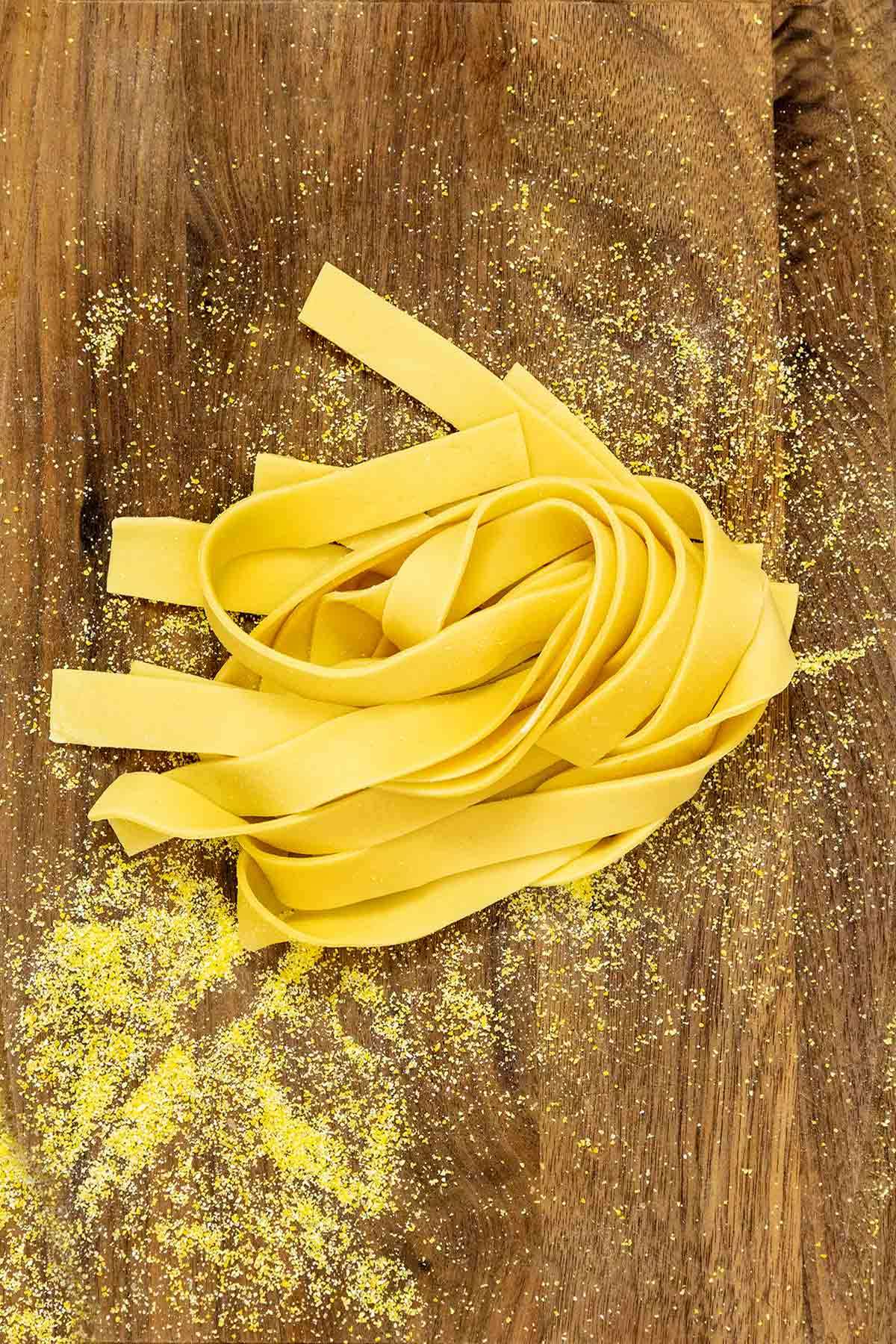
4.8 from 234 votes
Homemade Pasta Dough
This homemade pasta dough is foolproof and easy to make by hand or with your stand mixer with just eggs, flour, olive oil, and salt. Italian through and through. Here's how.
Prep Time
45 mins
Additional Time
30 mins
Total Time
1 hr 30 mins
Servings: 2 servings
Calories: 475 kcal
Course:
Main Course
Cuisine:
Italian
Ingredients
- 1 1/2 cups plus 1 tablespoon Italian "00" flour (or half Italian "00" flour and half farina di semola)
- 2 large eggs
- 1 tablespoon olive oil optional
- Pinch kosher salt
Instructions
Make the homemade pasta dough
- In a small bowl, beat the eggs well until combined.
- Dump the flour in a pile on a work surface (I like using a wooden cutting board) and make a well in the center with your hand. Pour the eggs into the well. Add the salt and oil if using.
- Using a fork, mix in the flour a bit at a time. Keep adding flour from the well wall and mixing until a firm, shaggy dough forms. If the dough feels dry, add a bit of water; if it feels too wet, sprinkle with a bit of the flour.
- Knead the pasta dough until it’s smooth and homogenous, 5 to 10 minutes. (Keep at it, it takes some muscle!) Roll the dough into a ball, wrap it with plastic, and let it rest at room temperature for at least 30 minutes so it can relax and hydrate.
Cup of Yum
Pass the dough through a pasta machine/attachment
- Cut the pasta ball in half. Wrap one half in plastic and set aside. Flatten the other half into a 1/2-inch-thick rectangle and carefully feed the dough through a pasta machine set on the widest setting. Once the pasta dough runs through the machine, fold it in thirds and feed it through once more, still on the widest setting.
- Repeat this process of passing the dough through the machine and folding it in thirds 4 more times. This conditions the dough, removes air bubbles, and makes it satiny smooth.
- Continue passing the sheet of pasta dough through the machine, gradually narrowing the setting, one notch for each pass, until the pasta achieves the desired thickness.
- Sprinkle a rimmed baking sheet liberally with cornmeal, lay the pasta sheet on top, and sprinkle with more meal. Let the dough air dry for about 5 minutes while repeating with the remaining pasta half
Cut the pasta by hand
- On a lightly floured cutting board, fold over the pasta in 2-inch sections to create a roll.
- With a sharp knife, cut the pasta crosswise into your preferred width. (I tend to cut these on the generous side.)Pappardelle about 1 inch wideTagliatelle about 1/2 inch wideFettuccine about 1/4 inch wideLinguine about 1/8 inch wide
- Immediately shake loose each bundle and toss it with cornmeal. Place the bundles on the rimmed baking sheet while you boil the water.
Cook the fresh pasta
- Bring 3 to 4 quarts of well-salted water to a boil. Toss in the pasta bundles, stirring to prevent the noodles from sticking to each other. Cook until al dente, 2 to 3 minutes, depending on the width and thickness of the pasta.
- Reserve 1/4 cup of the pasta water (it helps to emulsify the sauce you use) and drain the pasta.
- Return the pasta to the pot, stir in your sauce of choice. Dribble in a bit of pasta water--only if needed. Serve immediately with grated cheese.
Notes
- Don't worry if the dough seems rough, stiff, and slightly dry after kneading. The rest period helps it to soften and become smooth.
- To scale the recipe, allow approximately 1 egg to 3/4 cup of flour per entrée portion.
- Fresh pasta can be stored in the fridge, wrapped tightly with plastic, for up to 2 days. Freeze individual nests of 00-flour-dusted noodles in resealable bags or airtight containers for up to 4 weeks.
- Fresh pasta cooks much faster than dried pasta, but the exact timing depends on how thick your noodles are. On average, 2 to 3 minutes should be enough to cook freshly-made flat pasta, such as fettuccine, pappardelle, and linguine. After adding the pasta to boiling salted water, stir immediately and frequently to prevent sticking.
- Don't expect fresh pasta to behave like the dried pasta that you are used to. Fresh pasta is smoother in texture and more tender due to its hydration.
- Fresh pasta is also more delicate than its dried cousin, so treat it more gingerly.
Nutrition Information
Serving
1portion
Calories
475kcal
(24%)
Carbohydrates
72g
(24%)
Protein
16g
(32%)
Fat
13g
(20%)
Saturated Fat
3g
(15%)
Monounsaturated Fat
7g
Trans Fat
1g
Cholesterol
186mg
(62%)
Sodium
73mg
(3%)
Fiber
3g
(12%)
Sugar
1g
(2%)
Nutrition Facts
Serving: 2servings
Amount Per Serving
Calories 475
% Daily Value*
| Serving | 1portion | |
| Calories | 475kcal | 24% |
| Carbohydrates | 72g | 24% |
| Protein | 16g | 32% |
| Fat | 13g | 20% |
| Saturated Fat | 3g | 15% |
| Monounsaturated Fat | 7g | 35% |
| Trans Fat | 1g | 50% |
| Cholesterol | 186mg | 62% |
| Sodium | 73mg | 3% |
| Fiber | 3g | 12% |
| Sugar | 1g | 2% |
* Percent Daily Values are based on a 2,000 calorie diet.